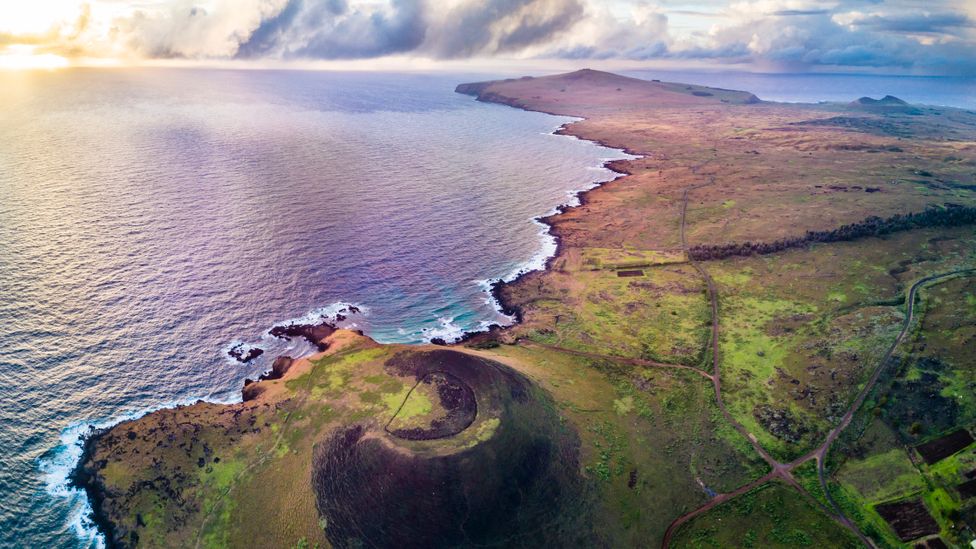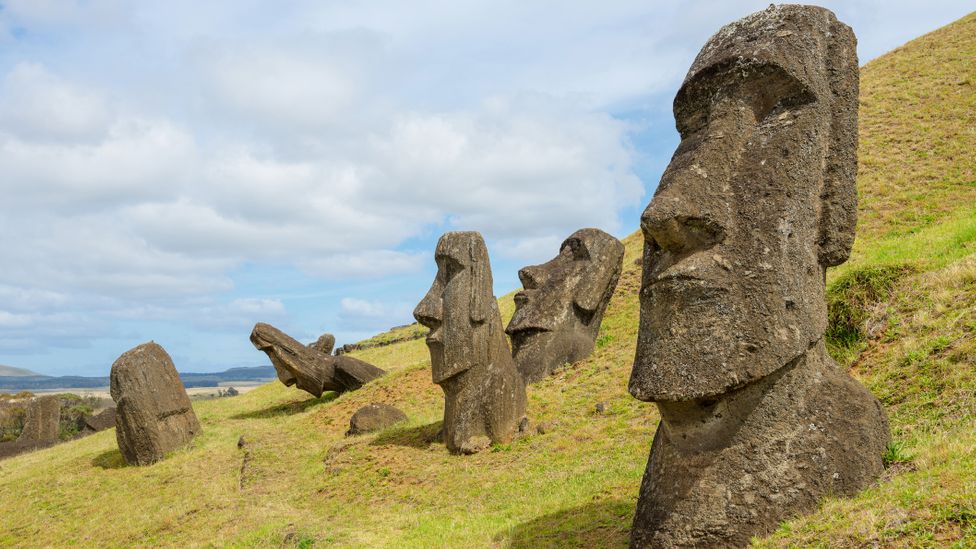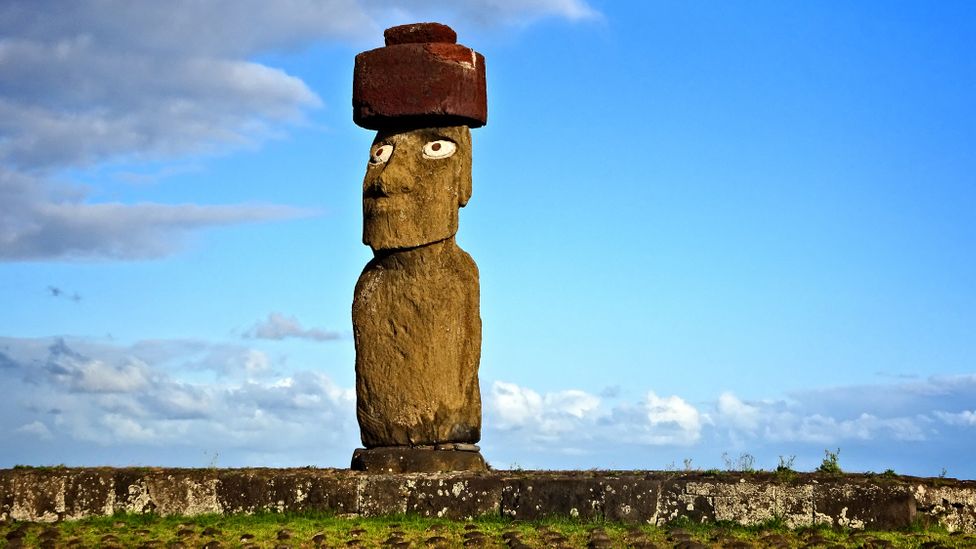Living on a remote, barren isle bestowed with few resources, the Rapanui needed to combine ingenious design with flawless sculpting to move the massive moai without any machinery.
he coastal winds whipped across my face as I craned my neck to see the 15 moai before me. Standing up to two storeys tall and with their backs to the choppy Pacific Ocean, the statues’ empty eye sockets, once embellished with white coral and red scoria, gazed perennially across Easter Island. Their bodies were etched with enigmatic symbols, and their faces, with prominent brows and elongated noses, seemed both comfortingly human and formidably divine.
There are 887 moai scattered across Easter Island, or Rapa Nui as the islanders call it, and these 15 were standing on the Ahu Tongariki plinth, the largest ceremonial structure on the remote Chilean isle. Looking up at the overly large heads and legless torsos, I found it hard to imagine how these giant monolithic figures – which weigh up to 88 tons and were built at least 900 years ago – could have even got here. But it wasn’t just me who was confounded: researchers have long puzzled over how these weighty moai were manually transported across the island.
Several theories have been proposed, including using logs to roll the statues and even the far-fetched belief of extra-terrestrial help. However, it seems that the secret lies in the marriage of ingenious design and flawless sculpting, which enabled these humanlike statues to stand upright and rock forward from side-to-side while being guided by ropes, granting the statues the ability to “walk”.
The movement would have been similar to the shuffle of a refrigerator being moved in a standing position, with each side inching forward one at a time. “But the Rapanui [the Polynesian peoples indigenous to Rapa Nui] went beyond that and actually carved the base of the statues and added certain angles in so that it was a better version for moving,” explained Carl Lipo, an archaeologist specialising in the moai and lead author of a 2013 study into how the statues moved.

Fifteen moai stand on the Ahu Tongariki plinth, the largest ceremonial structure on Easter Island
This was the first study that successfully “walked” a five-ton replica, and the walking theory it proposed “melds oral history and science”, according to Ellen Caldwell, art history professor at Mt San Antonio College in California who has expertise in ancient Oceanic art.
She notes that walking statues are a part of Rapanui oral traditions, with the word “neke neke” in the Rapanui language translating to “walking without legs”; and says that it is this phrase and such oral histories that Rapanui elders and descendants recall when answering how the moai were moved across vast distances without any machinery. Rapanui 𝘤𝘩𝘪𝘭𝘥hood nursery rhymes also tell stories about the statues walking; and legends say that a chief with mana, or supernatural power, helped the moai to walk.
There are plenty of ancestral songs and stories that talk about the moais walking
“The oral tradition of the island talks about the moai walking from the place where they were made to their final destination on top of the alters,” said Patricia Ramirez, who has lived on Rapa Nui since she was five and now works there as a tour guide. “Traditionally, the only way history was passed down on the island was through songs, through chants, through games and through poetry. There are plenty of ancestral songs and stories that talk about the moais walking.”

Walking the statues would have been an efficient transport method on a barren isle with few resources
However, although locals have long spoken of them walking, it took foreign scholars more than two centuries to accept this way of transporting the moai. “It’s really been just Europeans and other researchers sort of saying, ‘no, there must have been other ways, it couldn’t have been that’,” said Lipo. “There was no way we could think of moving the statues other than having lots of people. This turns out not to be true. The archaeological record really points to that.”.
Almost all the statues were created in the volcanic quarry of Rano Raraku before being transported to stone plinths (known as ahus) at different points on the isle’s coastline. Lipo’s study found that unfinished statues in the quarry and abandoned ones lying on the side of the island’s roads – ie ones that needed to be moved – had wider bases relative to shoulder width compared to the statues standing on the ahus. They also significantly leaned forward by around 17 degrees, causing the centre of mass to be positioned just over the rounded front bottom edge. These adjustments allowed the statue to roll from side to side and be transported to their final spot.
“What’s sort of stunning is that they’re so far forward leaning, they couldn’t stand up on their own because they would topple forward,” he said.
These features indicate that the moai were modelled after “our own way of walking”, said Lipo, explaining that when we walk, we rotate our hip and fall forward. “The Rapanui essentially created a structure that could do the same thing. As the statue leans forward, it falls and moves across the front to take a step forward.”
The walking moai would have been supported and guided by ropes, with a group of Rapanui people on each side of the statue leading the steps and a small group behind steadying the movement. Once the statue reached its ahu, stone carvers would chisel in eyes and reshape the base to adjust the centre of mass, allowing the statue to stand upright by itself.

Most of the moai were created in Rano Raraku, an extinct volcanic crater that served as the primary statue quarry
Why the Rapanui chose to walk the statues rather than drag them or roll them on logs came down to practicalities, according to Lipo. The weight of the sculptures would have crushed the logs, while dragging such huge moai would have demanded enormous manpower. On a remote, barren island bestowed with few resources, walking the statues would have been an efficient method. “You see the engineering that went into being able to make and move the moai with the least cost. The Rapanui people did it within the constraints of the island, basically by cooperation and ingenuity,” he said.
My walk from the Rano Raraku crater to Ahu Tongariki was just 800m in distance, but I wasn’t trying to guide an 88-ton moai with a few ropes. Other statues I visited stood on ahus up to 18km away from the quarry, making my bike ride there seem a breeze compared to the feats the ancient Rapanui civilisations accomplished.
Creating walking statues would have been a trial-and-error process. About 400 statues remain in and around the Rano Raraku quarry in various stages of completion, an indication that the stone carvers used the valley as an artistic laboratory to experiment with different prototypes before hitting on one that could be efficiently moved, said Lipo. “It really documents the history of craftsmanship, experiments, attempts and failures,” he added.
Once a statue was ready, it would be led out of the valley and guided towards its ahu. The ancient roads leading out of Rano Raraku were concave, which aided and supported the moai’s side-to-side rocking movements. However, not all moai made it to their ahus – some lost balance along the way and tumbled off the roads. Visitors to the quarry will see the ruins of dozens of abandoned statues littering the outer slopes and roadsides; it’s the best place on the island to get a sense of the immense number of moai created. Lipo’s study found that these fallen moai have breaks consistent with falls from a vertical standing position, strengthening the theory that they walked.

One of the moai has been restored, with its coral eyes and stone hat reminiscent of the original statues
Once the statue reached its destination and had been reshaped to allow it to stand upright, it would be lifted onto its ahu. At that point, the moai were sometimes topped with stone hats called pukao to give them aringa ora (living face), or, in other words, “their human form”, said Jo Anne Van Tilburg, an archaeologist specialising in Rapa Nui rock art.
Having a human-like appearance was important to the Rapanui, as the moai were used in rituals for the dead and to honour Rapanui chiefs. The Rapanui people believed the world of the living and the dead was continuous, explained Ramirez. “They weren’t content in only symbolically remembering their ancestors – they wanted to have physical images to represent them,” she added. “And that’s what the moais statues are. They are the faces of the dead ancestors.”
The first contact with the Europeans devastated their culture. It’s the same saga on all Polynesian islands
Lipo noted that the stone carvers may have sung ceremonial songs while the statues walked to maintain the rhythm of the movement, with different songs for different sized figures to match the pace of the moai’s movement. However, little remains of the oral history of the Rapanui people to confirm this. “A lot of the songs and stories were lost due to colonisation and missionisation,” said Tilburg. “The first contact with the Europeans devastated their culture. It’s the same saga on all Polynesian islands.”
Despite scientific research answering many of the most puzzling questions about the moai, the lack of oral and written history keeps Rapa Nui shrouded in myth. But it’s this element of mystery that lured me – and tens of thousands of other tourists each year – to this remote dot of an isle in the first place.
I pictured the 15 statues on Ahu Tongariki rolling side-to-side across the barren land, a celestial chant filling the air. Yet having walked the ancient unpaved roads of this south Polynesian island, these giant moai today stand unmoving and silent, their construction speaking volumes of the ingenuity of their past creators.





